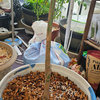brown sunken spots on meyer lemon fruit ( container grown )
birdman2009
11 years ago
Related Stories

FALL GARDENING5 Fall Fruits You Can Grow in Containers
Brighten your porch or patio with a potted pomegranate, kumquat, blueberry bush or another great fall fruit
Full Story
FARM YOUR YARDIf You Have Room for Only One Fruit Tree ...
Juice up a small garden with one of these easier-care or worth-the-effort fruit trees for a mild climate
Full Story
FARM YOUR YARDHow to Grow Vegetables in Containers
Get glorious vegetables and fruits on your patio with a pro’s guidance — including his personal recipe for potting mix
Full Story
EDIBLE GARDENSHow to Grow 10 Favorite Fruit Trees at Home
Plant a mini orchard in fall, winter or early spring to enjoy fresh-off-the-tree fruit the following year
Full Story
EDIBLE GARDENSHow to Grow Your Own Peaches and Nectarines
Make gardening a little sweeter with these juicy fruits, which you can eat after plucking or preserve for later
Full Story
SUMMER GARDENINGHow to Grow Basil
Bright color, quick growth and endless uses for cooking make this summer annual a winner in the garden or a pot
Full Story
SPRING GARDENINGTop 10 Scented Plants for Your Garden
A palette of perfumed plants can transform even the smallest of gardens into a sensory delight
Full Story
EDIBLE GARDENSSummer Crops: How to Grow Squash
Almost foolproof and with cheerful flowers, squash comes in a wide range of varieties to plant in spring
Full Story
EDIBLE GARDENSHow to Grow Your Own Sweet Summer Crops
This guide will help any gardener get started on growing the freshest warm-season veggies and berries for summer
Full Story
EDIBLE GARDENSHow to Add an Apple Tree to Your Edible Garden
Readily available, beautiful and fragrant, apple trees offer four-season interest along with crisp, juicy fruit
Full Story






hoosierquilt USDA 10A Sunset 23 Vista CA
johnmerr
Related Professionals
Simi Valley Landscape Architects & Landscape Designers · Tomball Landscape Architects & Landscape Designers · Wakefield Landscape Contractors · Williamsburg Landscape Contractors · Aberdeen Landscape Contractors · Columbine Landscape Contractors · Commack Landscape Contractors · Costa Mesa Landscape Contractors · Doctor Phillips Landscape Contractors · Fort Atkinson Landscape Contractors · Fountain Valley Landscape Contractors · Harrisburg Landscape Contractors · Nutley Landscape Contractors · Painesville Landscape Contractors · Reisterstown Landscape Contractorsbirdman2009Original Author
johnmerr
birdman2009Original Author
rhizo_1 (North AL) zone 7
Ryan
johnmerr
meyermike_1micha
hoosierquilt USDA 10A Sunset 23 Vista CA
rhizo_1 (North AL) zone 7
johnmerr
hoosierquilt USDA 10A Sunset 23 Vista CA
Ryan
hoosierquilt USDA 10A Sunset 23 Vista CA
birdman2009Original Author
rhizo_1 (North AL) zone 7
greenman28 NorCal 7b/8a
hoosierquilt USDA 10A Sunset 23 Vista CA
greenman28 NorCal 7b/8a